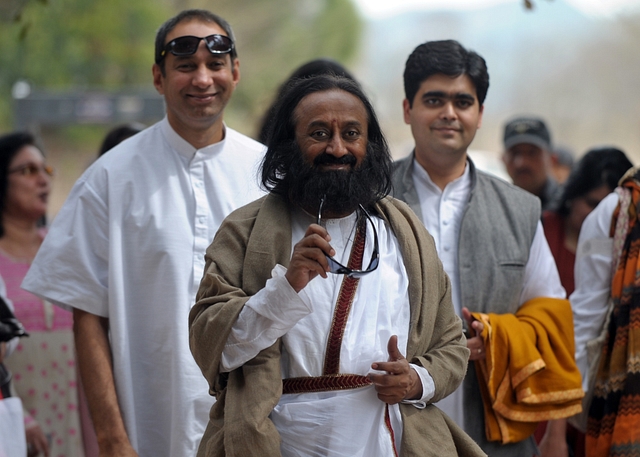
NGT’s Ruling On Sri Sri’s Yamuna Fest Is A Compromise, But A Reasonable One
The broader point made by the activists has to be internalised by spiritual leaders from every sect or religion because the environment cannot bear our assaults on it anymore.
Religious and cultural practices that defined our heritage are now contributing to poisoning our rivers, our atmosphere and mother earth.
We have to move to a more sensible and symbolic approach to rituals and practices of the past. We should keep the spirit and limit the damage we do.
The National Green Tribunal’s (NGT’s) order on Sri Sri Ravishankar’s World Cultural Festival on the banks of the Yamuna is a reasonable compromise for the simple reason it will make neither side happy. The Rs 5 crore fine on Sri Sri’s Art of Living (AOL) will be seen as a rap on the knuckles for ignoring environmental damage, while the conditional go-ahead to the festival (which begins tomorrow, 11 March) will be seen as too lenient for the kind of transgressions the green lobby has alleged.
It is obvious that AOL has goofed up on this aspect of its cultural festival, which is expected to bring in nearly 3.5 million visitors from 150-and-odd countries. For a spiritual group which has usually taken a progressive stand on environmental issues, including a significant contribution to cleaning the Yamuna itself, this is not something to be proud of.
However, it is equally likely that the orchestrated campaign - with media playing a big role - to stop the festival at the nth hour smacks of selective outrage focused on tripping a modern Hindu group in this climate of hostility generated by the rise of a Hindu-oriented political party to power. The “Secular-Left” prefers to see the Togadias and rabid Hindutva fringe elements rising rather than sensible iterations of Hindu spirituality, as represented by the likes of Sri Sri, since it is easier to demonise the former. One says selective outrage for there are several festivals involving other religions that also do environmental damage, but we don’t hear the same condemnations.
That this selectivity was important to stop-the-festival activists was evident from the attitude of at least one vocal advocate who was everywhere on TV. She repeatedly referred to Sri Sri as Mr Shankar, which suggests that showing disrespect to a Guru revered by millions was as important as showing respect to the environment she wanted to protect. But, even granting no such intent on her part, the time to stop the festival was before work on the stage and accompanying short-term infrastructure had begun. This is why the NGT order was a reasonable compromise.
But the broader point made by the activists has to be internalised by spiritual leaders from every sect or religion because the environment cannot bear our assaults on it any more. While there are many reasons why the environment is deteriorating, including industrial and vehicular pollution, this article would like to focus on the contribution of age-old religious practices to this damage.
Religious and cultural practices that defined our heritage are now contributing to poisoning our rivers, our atmosphere and mother earth. And its not just about Hindu practices.
The annual Haj, where millions of devout Muslims travel from all over the world to congregate in Mecca, is probably the single biggest cause of religion-induced damage in the world an ecologically sensitive desert zone.
Our Kumbh Melas, Ardh Kumbhs and various spiritual congregations in many temples and fairs too do enormous damage.
For example, the Hindu ritual of cremating our dead on the banks of the Ganga and immersion of our ashes in various rivers and seas is another factor in this ecological crisis.
Practices that defined our heritage and which made eminent sense when population levels were low have to be modified when we are a billion-and-a-quarter people crammed into thin strips of land along the peninsula and various river banks. If every Hindu wants to immerse his ashes in the Ganga or at the Triveni Sangam in Allahabad, the river systems that gave birth to our culture will be throttled. The Ganga has washed too many of our sins to be able to do its job efficiently in future. Our ecological sins are too serious for even the holy river to wash.
When faced with similar challenges in the past, we managed to change our practices from the real to the symbolic. From animal sacrifices we converted to virtual sacrifices in our sacred religious rites.
It is time to show that same creativity now by converting our cremation and other ceremonies to symbolic events with limited human damage to our rivers and the air. Even if we want to have our ashes immersed in the Ganga, it can be a small amount and even this should be in a spot that can be filtered of polluted material before it mingles back into the main river. We don’t have to pour gallons of ghee on sacrificial fires when a spoon will do, or bathe our deities with cans of milk when a symbolic cup will do.
We have to move to a more sensible and symbolic approach to rituals and practices of the past. We should keep the spirit and limit the damage we do. And the better off section of Hindu society have failed to set a good example by making marriages ostentatious, dowries extortionate, and rituals needlessly elaborate. Little wonder the poor can’t afford Hinduism any more.
But it’s not just Hinduism. All religions must introspect on this and bring about change.